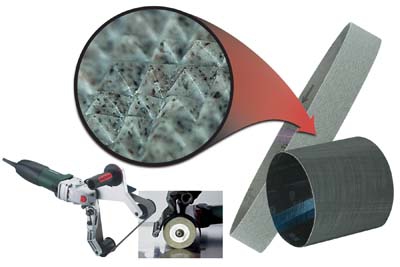
Metabo Corp. has introduced a line of Pyramid abrasives for use with its INOX tools that offer a better, more consistent finish than traditional metalworking abrasives, while providing high stock removal.
Unlike traditional abrasives that have material applied at random, Metabo's new aluminum oxide Pyramid abrasives feature a three-dimensional, structured geometric placement of the grains.
The calculated, geometric design allows finer grit sizes to remove more material, while giving work surfaces a consistent, even finish. Users can skip certain intermediary grit sizes to achieve the final finish faster, resulting in significantly reduced work time as well as increased service life of the belts and discs.
Available in 120, 280, 400, 600, 1200 and 2000 grit as well as in both belt and hook and loop disc design, Pyramid abrasives are ideal for use with Metabo's RBE12-180 pipe and tube sander, SE12-115 Burnisher and WE14-125 INOX angle grinder. These unique abrasives can also be used with other metalworking tools on the market.
Metabo's Pyramid abrasives are ideal for use on stainless steels, carbon steels, aluminum as well as other soft metals to perform a number of finishing applications in metalworking, including handrails, piping and decorative finishing applications.
Contact Details
Related Glossary Terms
- aluminum oxide
aluminum oxide
Aluminum oxide, also known as corundum, is used in grinding wheels. The chemical formula is Al2O3. Aluminum oxide is the base for ceramics, which are used in cutting tools for high-speed machining with light chip removal. Aluminum oxide is widely used as coating material applied to carbide substrates by chemical vapor deposition. Coated carbide inserts with Al2O3 layers withstand high cutting speeds, as well as abrasive and crater wear.
- carbon steels
carbon steels
Known as unalloyed steels and plain carbon steels. Contains, in addition to iron and carbon, manganese, phosphorus and sulfur. Characterized as low carbon, medium carbon, high carbon and free machining.
- metalworking
metalworking
Any manufacturing process in which metal is processed or machined such that the workpiece is given a new shape. Broadly defined, the term includes processes such as design and layout, heat-treating, material handling and inspection.
- stainless steels
stainless steels
Stainless steels possess high strength, heat resistance, excellent workability and erosion resistance. Four general classes have been developed to cover a range of mechanical and physical properties for particular applications. The four classes are: the austenitic types of the chromium-nickel-manganese 200 series and the chromium-nickel 300 series; the martensitic types of the chromium, hardenable 400 series; the chromium, nonhardenable 400-series ferritic types; and the precipitation-hardening type of chromium-nickel alloys with additional elements that are hardenable by solution treating and aging.






